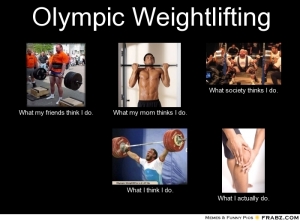Using the Olympic Lifts as Corrective Exercise
There are so many terms in fitness/training/strength & conditioning that are getting to be taboo. The most cringeworthy being “muscle confusion”, “functional training” (As opposed to dysfunctional training) and “core”….but the newest term to add to my list is “Corrective exercise”. Now, don’t get me wrong, I’m all about correcting muscle imbalances and I start all my programs with circuits that address individual issues. However, I believe we are getting so caught up in being pseudo “physical therapists” that we forget the point of a work out: to do WORK.
One of the first days of grad school, (After already achieving a few training certifications at this point) I had a class strictly dedicated to programming. We were given a case study, and told to address the concerns & come up with a program for the particular athlete. I remember being pretty pleased with my corrective exercise strategies, but when my professor looked at it, he laughed and asked me, “so… when do they actually lift weights?”. I was taken aback for a few minutes because I felt like I had included some good stuff: a variation of the back squat, lateral lunges, inverted rows, etc. Excuse me, what???
I had been familiar with the Olympic lifts and used them in a lot of my own programming, but didn’t particularly know how or when to program them (and all their variations) into a solid training program, particularly in an early phase of training. So, when I was given a case study of a typical basketball player, with a variety of issues (tight lower back, tweaked hamstring, tight external rotators, susceptible to ankle rolls…) I could really only focus on a corrective intervention. Isn’t that what everyone says? “You’re only as strong as your weakest link” “Do no harm” “[Any other cliche comment about correcting problems here]”…and all I knew was that the Olympic lifts are really freakin’ hard…even for someone with great mobility.
Eventually, as we got deeper into the semester, it occurred to me, most exercises we have were originally designed to help with dynamic flexibility, stability and strength IN ORDER TO complete the Olympic lifts to their full potential. Understanding this mentality helped me to design better programs with more lifting work being done, because I could understand how these exercises related to a higher goal (not just a body part). Even if you do not subscribe to the Olympic lifting school of training, or your athletes never progress to doing full power cleans or clean/jerks (which is completely fine, because you may decide it just isn’t worth the time to teach), you will still use a variety of exercises that are just Olympic lifting regressions (OH squats/lunges, RDLs, Deadlifts, Shrugs, Split Squats, just to name a few…)…so it’s cool to know why they exist and where they belong.
What’s the point of all this? Basically, don’t be afraid of higher work. Do your assessments, figure out your limitations (or those of your clients), but don’t get so caught up in simple correctives. I know some will argue that corrective exercises are difficult, and I completely agree (we had a class where we only did correctives for about 2 hours – I was so stiff the next day I felt like I had run sprints)– but if you could combine interventions (flexibility & stability) with your strength & power work – you would, right?
Check out Wil Fleming (the Olympic lifting guru) ‘s DVD ‘Complete Olympic Weightlifting’ – I love his system because it is simple, effective, and for all athletes. It is similar to the way I was taught to approach teaching and performing the lifts and I think it’s useful for just about everyone. Contrary to learning the style of Olympic lifting for actual Olympic lifters (which, remember, is a true sport, and the %’s and volumes are usually written as such for those looking to compete) or Crossfit that simply abuses my beloved O Lifts, this shows a great progression from soup to nuts.
I’m splitting the post up to let this idea marinate, but in part 2, I will break down the components and show how to classify these exercises for use among all types of lifters and athletes.
Posted on January 19, 2013, in Fitness, Lacrosse, Strength & Conditioning, Training and tagged corrective, injury prevention, lifting, olympic lifting, power, strength, swag, training. Bookmark the permalink. 2 Comments.

Hello,
I have a question about your blog, could you please email me? Thanks!!
Melanie
sure thing! what’s your email?